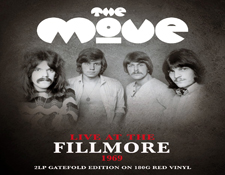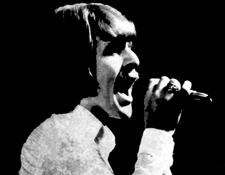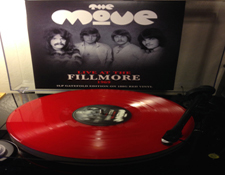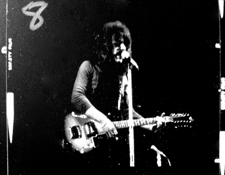It’s the time of year for saving money!
This one almost snuck by me: a new vinyl edition of The Move Live at the Fillmore 1969. Previously released only on CD a couple of years ago, this two-LP set is a bit of wonderment which fans of British Invasion music, early hard rock, psychedelia and — perhaps most significantly — the Electric Light Orchestra should take note of.
 ELO?
ELO?
Yup yup. ELO. Stick with me.
Part of the reason I’m writing this review is to remind people that before ELO there was this amazing band called the Move which ultimately morphed into the Electric Light Orchestra. As a group, the Move was pretty huge and influential in its native England but never quite broke out here in the United States. If you are a fan of Cheap Trick and like their song “California Man,” do understand that song was originally done by the Move. If you liked the ELO hit “Do Ya,” well then understand also that song was originally recorded and performed by the Move.
Probably as much a victim of their own creativity and relative lack of marketing focus — in their early days, the Move did lots of covers as well as choice originals — the band rode a remarkable wave of rapidly changing musical trends in its brief existence. Beginning around 1967, their first recordings were mostly driving Summer of Love-inspired pop rock with a decidedly British flair. The Move were mostly known as a singles band with a great live act that apparently even challenged the Who at times in its sheer stage bravado.
By 1969 mainstream rock music was getting decidedly heavier and so the Move transmogrified into a proto-heavy metal power-trio type band à la Led Zeppelin, Cream, The Who and others. On their new album that year — called Shazam — they offered up some new originals, a madly wonderful remake of one of their earlier hits and wildly expansive arrangements of songs from the pop and folk world written by the likes of Barry Mann & Cynthia Weill and even Tom Paxton!
Preparing for their only US tour that year, they expanded their heavier offering with long jams on tunes by Goffin & King (“Goin’ Back,” which the Byrds had been doing around that period) and even two by Todd Rundgren’s original band the Nazz (note: Rundgren recorded the Move’s “Do Ya” several years later!)
 It is this incarnation of the Move that we get to hear on a sweet surprise vinyl release of The Move Live at The Fillmore 1969. After this tour, lead singer Carl Wayne would exit the band and Jeff Lynne would join the group for two albums as he and Move co-founder Roy Wood simultaneously plotted the introduction of ELO to the music world. But that is an entirely separate story …
It is this incarnation of the Move that we get to hear on a sweet surprise vinyl release of The Move Live at The Fillmore 1969. After this tour, lead singer Carl Wayne would exit the band and Jeff Lynne would join the group for two albums as he and Move co-founder Roy Wood simultaneously plotted the introduction of ELO to the music world. But that is an entirely separate story …
This live-from-the-soundboard type performance had been preserved by Wayne, who was working on the restoration when he passed away in 2004. It was his wife who saw the project through to ensure its eventual release in 2011. When the CD came out, it was a Godsend (if you will) for fans of the Move.
The music, performances and sound quality — especially given the time frame and circumstances surrounding its existence — is simply stunning. On this live recording, the Move perform the music from their then-just-released studio album Shazam. With the performances fine-tuned through a series of shows across the country, the live versions sound as good as or better than the studio recordings.
If you know Shazam and how complex it is, that makes The Move Live at The Fillmore 1969 all the more compelling.
]]>The CD version released in 2012 sounded great and is essential to own becasue it has bonus tracks of performances from additional nights at the Fillmore, not found on the LP. It also has an audio recollection of the tour by drummer Bev Bevan.
 The LP, however, sounds even better still, with a somewhat larger soundstage, richer bass sounds and an overall warmer feel than the purely digital incarnation. Even though it is not perfectly “mixed,” the recording doesn’t really suffer from the slight imbalance — the vocals are a little “hot” in the mix relative to the rest of the band’s instruments. That is the only caveat I have to mention, as some people might prefer the more well-blended and aurally pristine studio versions.
The LP, however, sounds even better still, with a somewhat larger soundstage, richer bass sounds and an overall warmer feel than the purely digital incarnation. Even though it is not perfectly “mixed,” the recording doesn’t really suffer from the slight imbalance — the vocals are a little “hot” in the mix relative to the rest of the band’s instruments. That is the only caveat I have to mention, as some people might prefer the more well-blended and aurally pristine studio versions.
The pressings on The Move Live at the Fillmore 1969 are lovely, on thick, perfectly pressed and well-centered 180-gram red vinyl. The discs are housed in a beautifully designed mostly black and white gatefold cover featuring images of the band on tour and performing live (one assumes they were live shots from the Fillmore East).
The Move at the Fillmore 1969 is a great package.
It is also a great value: I found it selling online for about $20 from a retailer here in the United States (unheard of for a 180-gram UK import)!
I’m not quite sure how that happened but it did and thus it raised my risk-reward ratio for taking the chance on buying it essentially blindly.
It’s not like I read a press release about its release or received a promotional e-mailer from the Move/ELO fan clubs. Nope, I just happened upon The Move Live at The Fillmore 1969 while searching for something else on the Internet. I’m happy that it appears to be a very legitimate release and very much a complement to the 2012 CD set on Right Recordings.
You can find more information on this release at www.notbadrecords.co.uk.
 I really can’t say enough about this album. Its a great performance, lovingly packaged and priced in a way that even the casual / curious listener might be willing to take a chance on in order to learn about a great band that has inspired so many other over the years.
I really can’t say enough about this album. Its a great performance, lovingly packaged and priced in a way that even the casual / curious listener might be willing to take a chance on in order to learn about a great band that has inspired so many other over the years.
Frankly, the producers of this album could have playfully named it after debut titles by other British Invasion bands like The Beatles and Rolling Stones — “Meet the Move” or “Introducing the Move” — and it would not have been out of place. This was effectively the first time most Americans got a chance to hear the Move play live.
The Move Live at The Fillmore 1969 is thus an essential document. Get it.






